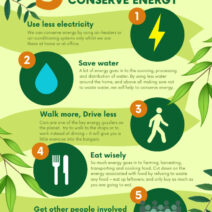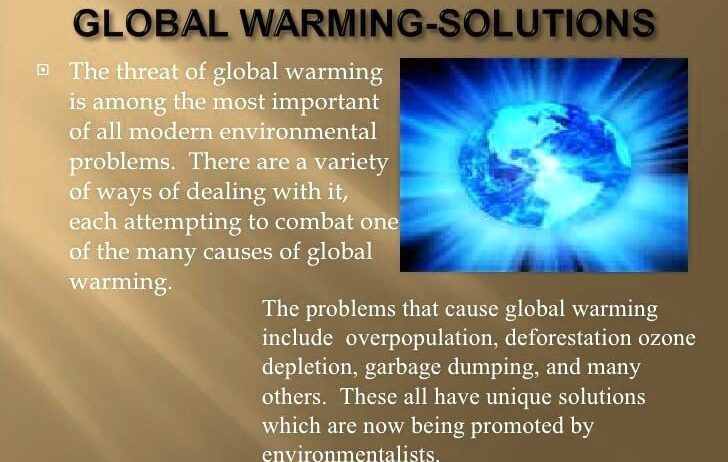Global warming, a dire conundrum enveloping our planet, can be likened to a slowly tightening noose around the neck of Mother Earth. The toll of industrialization, fossil fuel combustion, and deforestation has engendered a perilous imbalance within our atmosphere, leading to ominous manifestations such as extreme weather events, rising sea levels, and irrevocable biodiversity loss. As custodians of our environment, governments wield significant influence and responsibility in orchestrating a multinational symphony of solutions necessary to combat this existential crisis. This discourse will traverse a myriad of strategies that can be adopted by governmental entities to mitigate the effects of global warming.
Transitioning to Renewable Energy: One of the most compelling solutions is a pivot towards renewable energy sources. As sunlight unfurls its warmth across the earth, solar energy stands as a beacon of hope. Wind power, akin to a tireless steward of the skies, harnesses natural breezes to generate electricity. By investing in these sustainable alternatives, governments can significantly reduce reliance on fossil fuels, thereby curtailing greenhouse gas emissions. Subsidizing solar panel installations and wind farms can catalyze this transformative journey, creating a vibrant energy landscape that thrives on sustainability.
Revamping Transportation: Our transportation systems resemble a sprawling web, intricately interlaced with carbon emissions. To unravel this tangled mess, governments must champion the development of public transport networks and incentivize electric vehicles (EVs). By investing in advanced infrastructure such as robust railway systems and expanding charging stations for EVs, governments can effectively diminish the carbon footprint of commuters. Public campaigns promoting the use of bicycles and electric public transport options can further integrate sustainable practices into daily life.
Enhancing Energy Efficiency: Imagine a shimmering castle illuminating the night; however, if its windows are open, much of that light escapes into the dark abyss. In a similar vein, energy efficiency in buildings must be paramount. Enforcing stricter building codes that mandate energy-efficient designs or retrofitting existing structures to enhance their thermal performance can curtail energy wastage dramatically. Funding programs and tax incentives for energy-efficient appliances can create a ripple effect, encouraging citizens to prioritize sustainability.
Carbon Pricing Mechanisms: The concept of carbon pricing can be viewed as a corrective lens aimed at exposing the hidden costs of carbon emissions. By imposing taxes on carbon emissions, the government can incentivize industries to innovate and transition towards cleaner technologies. This market-based approach aligns economic interests with environmental responsibility, promoting cleaner practices while simultaneously generating revenue that can be reinvested into further environmental initiatives.
Reforestation and Afforestation: Imagining a world without trees is akin to a painter devoid of their palette. Forests act as crucial carbon sinks, sequestering atmospheric CO2 and stabilizing ecosystems. Governments can spearhead reforestation and afforestation efforts, utilizing native species to restore deforested regions. Implementing policies that encourage sustainable forestry management ensures that our timber resources are harvested responsibly while preserving ecological balance.
Encouraging Sustainable Agriculture: Agriculture, often seen as a quaint countryside affair, is a significant contributor to global warming through methane and nitrous oxide emissions. Governments can foster sustainable agricultural practices by incentivizing organic farming, agroforestry, and regenerative agriculture techniques. By promoting crop rotation and reducing chemical fertilizers, they can cultivate soil health, enhance biodiversity, and diminish the agricultural sector’s carbon footprints.
Climate Education and Public Awareness: Without knowledge, the path to change remains obscured. Governments must prioritize climate education, establishing programs that disseminate information about the climate crisis and its solutions. By engaging communities through workshops, campaigns, and digital initiatives, a sense of urgency can be cultivated. This grassroots movement can lead to substantial shifts in public behavior towards a low-carbon lifestyle.
International Cooperation and Agreements: Global warming transcends borders, akin to a pervasive fog that blankets the entire earth. It necessitates international cooperation and unified action. By fostering partnerships and participating in global accords like the Paris Agreement, governments can align their climate goals with global standards. This collaborative approach encourages a shared commitment to combating climate change, as nations can benefit from shared resources, technology, and expertise.
Protecting Biodiversity: The interdependence of species forms the foundation of our ecosystems. Governments must prioritize the protection of biodiversity through the establishment of protected areas and wildlife reserves. By safeguarding habitats and promoting conservation efforts, they can preserve the vital functions of ecosystems that mitigate the effects of climate change. Biodiversity-rich ecosystems offer resilience against climate impacts, further emphasizing the need for their protection.
Conclusion: The battle against global warming is akin to navigating a tumultuous sea. While the waves of climate change may be daunting, proactive government intervention can chart a course toward sustainability and resilience. By intertwining innovative renewable energy solutions, investing in efficient transportation, promoting sustainable agricultural practices, and fostering international collaboration, governments can transform the tides of atmospheric distress. The multifaceted strategies proposed offer a roadmap to navigate the complex waters of climate change, ushering in a future wherein humanity coexists harmoniously with the planet.








